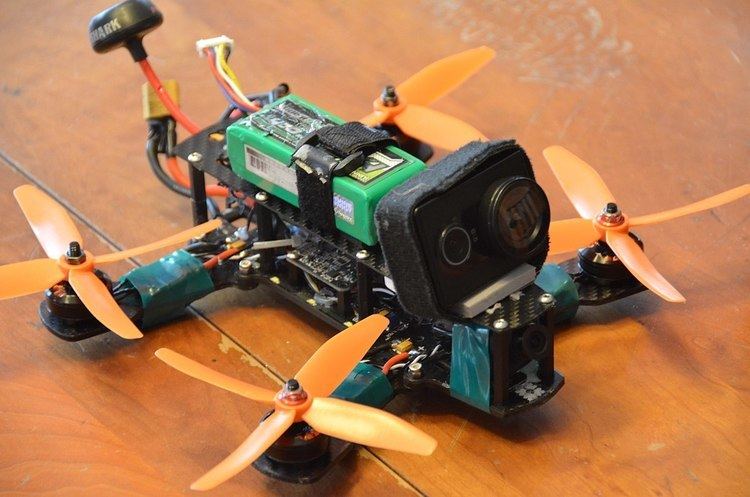 | ||
FPV drone racing (where FPV stands for first-person view or first person video) is a motorsport type where participants control "drones" (typically small radio-controlled aircraft or quadcopters), equipped with cameras while wearing head-mounted displays showing the live stream camera feed from the drones. The goal is to complete a set course as quickly as possible. Drone racing began as an amateur sport in Australia in late 2014.
Contents
Drone racing technology
FPV (first person view) flying means that pilots only see what the drone sees. This is accomplished by live streaming footage from a camera mounted on the nose of the drone. The image is transmitted via radio waves (typically 2.4 GHz or 5.8 GHz frequency) to goggles worn by the pilot. The remote control, drone, and goggles are all connected via radio and must transmit with sufficient speed and reliability to allow effective control. This technology is very new and is constantly being improved. FPV goggles on the market range from $50 to $500, with the more expensive goggles offering more and better features. Some of these features include a wide field of view (FOV), head tracking, multiple frequency settings, and DVR recording functionality .
While the pilot always requires goggles, some drone racing organizations insist they should also be used among spectators alike by simply switching the frequency to the channel of the racer you want to watch.
Any drone could be used to race, however competitive FPV racing leagues require drones to meet certain standards. The Drone Racing League (DRL) makes all of the drones used in its events in house; pilots are supplied with drones, backup drones, and parts by the league itself, not independently.
In contrast MultiGP, defines community produced specifications and allows participants to supply their own drones increasing competitiveness and innovation. For competition, aircraft are typically separated into classes, separating winged craft from rotorcraft; and also categorising by size and power.
Racing drones are designed to focus all of their energy into moving forward, as opposed to a photography/video drone which is focused more on hovering. A photography quadcopter design will typically have four motors configured in an X-pattern, all equally spaced apart. A racing model will typically have its four motors configured in an H-pattern configured to thrust the drone forward, not up. Because of their light weight and electric motors with large amounts of torque, drones can accelerate and maneuver with great speed and agility. This makes for very sensitive controls and requires a pilot with quick reaction times and a steady hand.
Course design
Leagues such as the DRL focus on tight fast-paced courses with many obstacles making it difficult not to crash.
Others such as the U.S. National Drone Racing Championship tend to conduct their races in open areas with less catastrophic obstacles (flags and cones vs. walls and tunnels). [5]
MultiGP provides community standards for their chapters to safely design their own courses and also generates individual pilot competition through their Universal Time Trial Track program which ranks pilots worldwide on standard measured courses.
Different leagues have different types of courses and regulations. The DRL for example can afford to race in dense areas full of obstacles because they can afford to repair or replace a crashed drone. Recreational flyers are less likely to take such risks. Nonetheless, continual improvements in drone technology are allowing pilots to fly for less and less money each year.
Organizations
FPV racing organizations create regulations and rules to offer a fair race among its pilots.
Past major events
Events and venues
The U.S. National Drone Racing Championship took place at the 2015 California State Fair. It was a 2-day event with a $25,000 cash prize that attracted over 120 competitors. This was the first event like this in the US, however other countries like France, Australia and the UK had previously held similar events. In 2016, the annual MultiGP Championship was held at the Academy of Model Aeronautics' headquarters in Muncie, Indiana where over 120 pilots competed by qualifying through the MultiGP Regional Series which consists of qualifying events and regional finals in 15 regions across the United States.
England
The British Drone Racing League (BDRL) has recently setup and will operate a number of professional events. The English Events are currently being organized and will follow compliance from the CAA.
Funding
It is currently difficult for these leagues to find funding due to the lack of knowledge about this up-and-coming sport. At events like the one held at the California State Fair, funding comes from the state and from ticket sales at the event. Along with the difficulties of finding funding, it creates problems of finding good venues that create a challenge for the pilots and also have key turns and straightaways adding to the exhilaration of these events. However, the Drone Racing League has just received a $1 million investment from the owner of the Miami Dolphins football team. This is crucial to the development of the league, and allows them to advertise and hold their races in better venues that will attract larger crowds. US Army veteran Brett Velicovich has been involved in the launch of drone racing at the Dew Tour.
Most events are sponsored by FPV manufacturers such as Fat Shark, ImmersionRC and HobbyKing.
